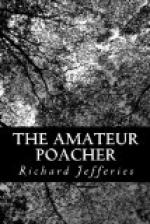The coombe was full of fir-trees; and by them stood a long narrow shed—the roof ruinous, but the plank walls intact. It had originally been erected in a field, since planted for covers. This long shed, a greenish grey from age and mouldering wood, became a place of much interest. Along the back there were three rows of weasels and stoats nailed through the head or neck to the planks. There had been a hundred in each row—about three hundred altogether. The lapse of time had entirely dissipated the substance of many on the upper row; nothing remained but the grim and rusty nail. Further along there hung small strips without shape. Beyond these the nails supported something that had a rough outline still of the animal. In the second row the dried and shrivelled creatures were closely wrapped in nature’s mummy-cloth of green; in the third, some of those last exposed still retained a dull brown colour. None were recent. Above, under the eaves, the spiders’ webs had thickly gathered; beneath, the nettles flourished.
But the end of the shed was the place where the more distinguished offenders were gibbeted. A footpath, well worn and evidently much used, went by this end, and, as I afterwards ascertained, communicated with the mansion above and the keeper’s cottage some distance below. Every passenger between must pass the gallows where the show of more noble traitors gave proof of the keeper’s loyal activity. Four shorter rows rose in tiers. To the nails at the top strong beaks and black feathers adhered, much bedraggled and ruffled by weather. These crows had long been dead; the keeper when he shot a crow did not trouble to have it carried home, unless a nail was conspicuously vacant. The ignoble bird was left where he fell.
On the next row the black and white of magpies and the blue of jays alternated. Many of the magpies had been despoiled of their tails, and some of their wings, the feathers being saleable. The jays were more numerous, and untouched; they were slain in such numbers that the market for their plumage was glutted. Though the bodies were shrunken, the feathers were in fair condition. Magpies’ nests are so large that in winter, when the leaves are off the trees, they cannot but be seen, and, the spot being marked, in the summer old and young are easily destroyed. Hawks filled the third row. The kestrels were the most numerous, but there were many sparrow-hawks. These made a great show, and were stuck so closely that a feather could hardly be thrust between them. In the midst, quite smothered under their larger wings, were the remains of a smaller bird—probably a merlin. But the last and lowest row, that was also nearest, or on a level with the face of a person looking at the gallows, was the most striking.




